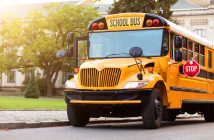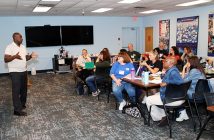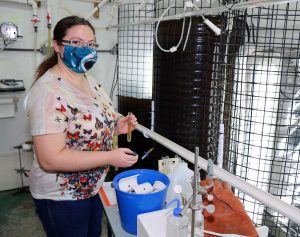
Environmental Aide Amanda Dauman tests samples of the algae that is being grown in the shellfish hatchery’s algae room. Algae is the energy base of the food web for all aquatic organisms.
MONTAUK — For more than one year, New York has been grappling with the overwhelming impact of the COVID-19 pandemic.
Some New York City residents relocated to the east end of Long Island to ride out the pandemic, which put a huge stress on local grocery stores that were unprepared for the influx of people, particularly as some stores lacked many supplies during the pandemic’s early days.
CSEA members working in the Town of Brookhaven’s Shellfish Hatchery have been helping to alleviate that unexpected strain on resources with their work breeding, raising and releasing shellfish into the bays of East Hampton Township.
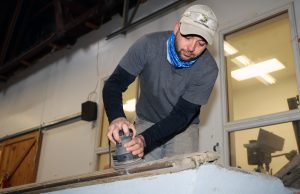
Waterways Maintenance Mechanic Jeremy Gould repairs a traditional bayman boat for the east end waterways.
“I have friends who are commercial fisherman who rely on selling the shellfish they catch in the harbor to feed their families,” said Waterways Maintenance Mechanic Jeremy Gould. “That is keeping the baymen economy going as well as supporting the big uptick in recreational fishermen who are gathering shellfish for dinner.”
The process begins with growing algae and bringing in brood stock [mature shellfish used in aquaculture for breeding purposes]to the hatchery where they will be spawned. Then, the shellfish are grown until they are big enough to be brought over to the nursery where they are carefully watched until they are big enough to go out into the field where they are raised until they are mature enough to be released into local waterways.
Aside from being used for sustenance, oysters are an important part of the ecological structure because they clean the water.
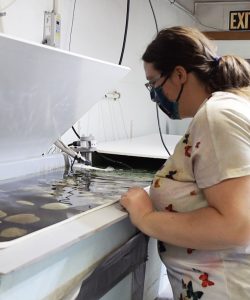
Amanda Dauman, an environmental aide, checks on the progress of oysters being grown at the shellfish hatchery.
“Oysters are filter feeders. They clean the water and make the water clearer, so it is a better habitat for seagrass, which makes the bays a better environment for other aquatic life that come into the bays,” said Environmental Aide Amanda Dauman. “The better the water quality, the more fish come into our waters, which directly impacts commercial fishermen.”
Like other frontline workers, CSEA members working at the Town of Brookhaven Shellfish Hatchery did not have the option of working from home. Much like farmworkers, their job entails caring for living creatures that need to be fed and cared for daily.
To comply with social distancing guidelines, all public programs at the facility were canceled, including the Oyster Gardening Program that allows residents to grow their own personal oyster crop throughout the year.
With all of the runoff that is coming from the increased residency on the east end, having a strong oyster and shellfish production program in place has been crucial.
“I don’t know if there’s been any studies, but there has to be a tie between our water quality and the amount of people that have moved out here since the pandemic,” said Gould. “It’s more important than ever that we have this shellfish program to combat the additional strain on our environment.”
— Wendi Bowie


